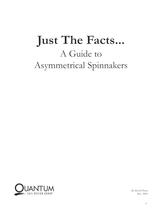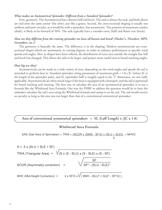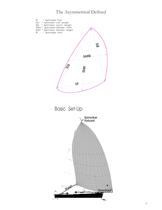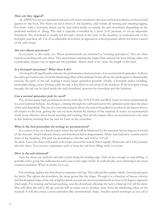
Catalog excerpts

Asymmetrical Spinnakers SAIL DESIGN GROUP Rev. 2000
Open the catalog to page 1
What makes an Asymmetrical Spinnaker Different from a Standard Spinnaker? First, geometry. The Asymmetrical has a distinct luff and leech. The tack is always the tack, and both sheets are tied onto the same corner (the clew), just like a genoa. Second, the cross-sectional shaping is usually not uniform and semi-circular, as it would be with a spinnaker, but asymmetric. The position of maximum camber (draft), is likely to be forward of 50%. The sails typically have a rounder entry (luff) and flatter exit (leech). How are they differentfrom the cruising spinnaker we have all known and loved?...
Open the catalog to page 2
SLU * Spinnaker Luff Length Basic Set-Up
Open the catalog to page 3
An ASP INN is set on a spinnaker halyard, with sheets attached to the clew and led aft to blocks on the leeward quarter of the boat. The sheets are led in front of the headstay, and outside all running and standing rigging. For boats with a bowsprit, sheets can be lead either inside or outside the tack downhaul, depending on the preferred method of jibing. The tack is typically controlled by a short (3-6') pennant, or via an adjustable downhaul. The downhaul is usually led through a block at the base of the headstay or outboard end of the bowsprit, and then aft. Use of an adjustable...
Open the catalog to page 4
Twings Help Control Sail Shape
Open the catalog to page 6
broader angles, is to "twing," or move the sheet lead forward, (see diagram). This keeps the clew from rising up and dumping off the leech, making the sail more symmetrical and powerful. How deep (broad) an angle you can sail is largely a function of breeze velocity. The lighter the air, the higher the angle (closer to the wind) you will need to sail to keep the asymmetrical full and pulling. To find the optimum angle for a given breeze velocity, start with sail full and pulling and bear off slowly till the clew begins to droop and the sheet begins to lose pressure, then head back up till...
Open the catalog to page 7
Is an asymmetrical as fast as a conventional spinnaker? They are better reaching sails, but not as good when broad reaching or running. This means they work best on high performance monohulls or multihulls. These boats go fast enough to pull their apparent wind forward; effectively they are always reaching. On slower displacement boats, once the breeze is blowing between 10 and 14 knots true, they just don't go that much faster. This means that the apparent wind doesn't go very far forward, and that making the best VMG (speed straight downwind), is a matter of sailing at broader angles. Not...
Open the catalog to page 8All Quantum Sails catalogs and brochures
-
MAINSAIL TRIM GUIDE
4 Pages
-
IQ Technology Sheet
3 Pages
-
Cruising Precision Recut
6 Pages
-
Racing Precision Recut
6 Pages
-
Matte film brochure
4 Pages
-
cruising - woven
4 Pages
-
cruising
4 Pages
-
racing - spinnaker
4 Pages
-
racing
4 Pages
-
210
11 Pages
-
Beneteau First 36.7
1 Pages
-
Fusion_M
16 Pages
Archived catalogs
-
Cruising Sails
11 Pages
-
PROPER SAIL CARE
1 Pages















